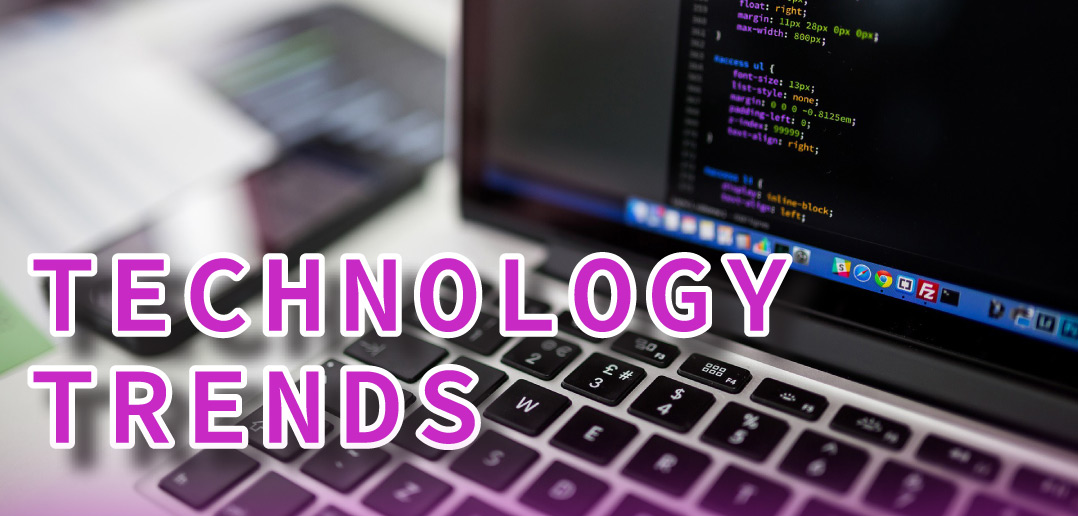Technology Trends in Omaha, NE – 2018
While you’ll find innovation anywhere you look in the business world, the pace of this in the technology industry in particular is staggering. Staying in the know can be a challenge for someone who isn’t actively involved in the field in some manner—and just when you think you’ve got a good grasp on it, the latest and greatest thing comes out and there’s a new learning curve ahead. That being the case, it’s wise to utilize the expertise of the professionals to guide you through selecting what works best for your business, implementation, troubleshooting, and so on. This way, you can stay busy doing what you do best while they provide insight and support on what they do best.
Information Technology (IT) Support
First, you’ve likely heard the adage “You can’t look forward without looking back.” To give a little bit of context on the rapid evolution of the tech industry, and more specifically something that many businesses are very familiar with, information technology or IT, Adam Walter with Virtual C shares, “Often we forget that the field of information technology (IT) is very young. A problem that has existed for quite some time is the lack of seasoned professionals. The first round of IT professionals graduated from college in the early 2000s, and before that, there was not even a degree for IT. This means a truly seasoned professional has 15-20 years of experience at most.”
So how does that factor into tech trends that apply to businesses today? Walter explains, “There are still very few of these seasoned professionals available, but with our reliance on technology, we are desperate to hire the best. With this new field depth, a new trend that we are seeing is an increase in the use of management consulting to take advantage of these professionals. Other industries have enjoyed this luxury for decades, but information technology has largely had to forge the paths alone. For the first time, IT professionals are able to hire executive level consultants to help with their departments.
Of course, at Virtual C we are most excited for this new level of engagement as IT shops around the world start shifting into a new level of professionalism. No longer does the small IT shop have to work alone. Now, CEOs have someone to turn to if they are concerned with technology in-house. The biggest thing our clients are asking for from us currently is agile (cultural) transformation, which is focused on helping departments increase communication and connect with business processes. They are really enjoying this new methodology as it starts creating an atmosphere of innovation in a stagnant field. It also creates a much more relaxed company as technical staff are able to adapt to the business much more quickly.
I really believe that IT coaching and fractional management will become more popular; through coaching IT, staff can have a mentor to accelerate their growth. Through fractional management; companies are able to save a lot of money by hiring more experienced staff than they could normally afford and gain an edge on their competitors.”
When asked if there was anything new offered by Virtual C on the horizon, Walter’s quick and enthusiastic is as follows: “Indeed there is! We are launching a new product called ‘Soundboard’ where any company can engage Virtual C to help solve a problem, review a contract, or just bounce ideas. We realized that not every company needs a long-term commitment. Sometimes you just need a professional to make sure you are making the right decision, or to help negotiate a contract. This is what Soundboard is built for. For a few thousand dollars, you can have a panel of professionals solve the problem facing your company. Our soundboard has helped companies land large contracts, resolve issues with personnel management and caught errors that would have cost millions of dollars. Don’t know if you should move to the cloud? Are you struggling with personnel? Do you need to deal with an underperforming vendor? Or perhaps you just need help negotiating a complicated RFP. We are here to help.”
Along the same lines, he also provides a word of caution. “Avoid the trap of thinking that more technology will help your company. Technology adoption should be appropriate to the business needs. My advice to entrepreneurs and business owners out there is to avoid letting technology drive your business. Focus on what your business does and see if technology fits and augments what you do. If it does not, then it is unnecessary overhead.”
Virtual/Augmented Reality (VR/AR)
Walter also identified this as a trend to watch for as it is predicted to rapidly evolve in the coming years. “I really think Augmented Reality will be a major player in technology in the future,” he poses. “As a construction worker, imagine being able to see where underground lines are in real time as GIS data is overlaid on your safety goggles. Imagine a school classroom where you can study the solar system as a 3D model. Perhaps in a business you might have space where your remote co-workers can walk and talk to each other as if they were physically located in the same space? There are a wealth of exciting possibilities across all industries.”
The Cloud
Although it’s now relatively common knowledge to know what it means to be in/on “the cloud.” This was not the case even just a few years ago. This trend emerged with the introduction of various cloud-based services and collocation centers with servers designed for extensive data storage. True to form, in the modern context of “cloud computing,” what was forecasted as something that would change how we operate entirely did just that in a little over a decade’s time. As the user base has steadily grown, it’s become the standard for how we store, access, and use our data, online and off-site, to conduct our business operations (and for personal use, too).
Cloud-based solutions empower businesses to stay current with technology without having the inconvenience and expense of owning, managing and maintaining large in-office equipment.
“Among a number of technology-related trends that have emerged recently, cloud computing has been one that’s seen significant growth,” says Jarrod Daake with Five Nines. “The price point is becoming more accessible for those in the SMB market and adoption rates are increasing.
I’m excited about cloud computing. A growing number of our clients use cloud services and that number will continue to grow into the future. As the prices continue to decrease, businesses are able to design a highly available system with little upfront capital expenditure.”
Expanding a little more on what’s to come, he also offers the following insight: “The future of SMB technology will vary largely depending on the vertical. Highly-regulated industries will migrate to cloud computing more slowly than those in other industries. Security demands will continue growing well into the future, and along with cloud computing, will be the largest growing technology expenditure for the SMB market. Business continuity and disaster recovery will have an increasing importance for SMBs as well.
Five Nines is currently expanding our service offerings to include managed firewall and security services. As businesses become more regulated, we’ve had to continue to grow and enhance our business in the area of cyber security. We feel we have a strong offering at a very competitive price and thus far, our clients have been very pleased.”
To sum it up, he states, “The tech landscape overall will continue focusing on security, scalability, and cloud computing. Other overarching themes will be machine learning and consolidation of network management.”
Artificial Intelligence (AI)
Daake also made note of how artificial intelligence will continue to evolve, making it another great example of what looks to be a game-changer for all types of businesses.
“Artificial intelligence is another emerging technology that will become the standard for all antivirus and antimalware software in the near future.
Artificial intelligence and machine learning has the potential to be very disruptive technology in the coming years. It isn’t hard to imagine a future when a computer will see a server or network issue and automatically remediate those issues. Many things can be automated now, and if they can automated, there is no reason as to why a computer couldn’t automatically do that in the future.”
Remote Monitoring
Remote monitoring for companies used to be considered a luxury. Now it’s not only a standard, it’s considered necessary and even mandated (with penalties incurred if not done). In all things technical, successful condition monitoring of equipment plays a key role in predictive maintenance and helps prevent costly downtime by allowing problems to be detected before they become severe.
Angela Wilson, CEO of Predictive Technology, Inc. (PTI), speaks on the trends of remote monitoring, “PTI is seeing a big push towards remote monitoring of equipment and conditions within facilities. We have seen a stronger growth in the need for remote monitoring of critical equipment and the facility environment that supports business viability within the utility, telecom, medical, transportation, and government industries recently. Especially with industries that have multiple locations and/or have facilities in remote and difficult locations to support. These organizations are using remote monitoring to manage equipment maintenance, service, individual device viability, efficiencies, and predictive analysis of possible device failure.”
Wilson adds, “Remote monitoring is ever-evolving, just as all tech trends seem to be in a constant state of change. “We are just scratching the surface on cloud based software to monitor multiple and/or remote locations. It will continue to evolve as well as wireless technology. I see the cloud monitoring expanding into all aspects of business. Every business wants and needs to protect its equipment.”
Understanding asset performance is key to optimize your operations and prevent costly downtime events. Remote monitoring and analytics provides a simple and secure approach to help monitor equipment and collect valuable performance analytics. It can give you valuable insights into how well your assets are working and alert you when performance falls outside of acceptable performance standards. Utilizing professionals, like the ones at PTI Solutions, can make the process of monitoring equipment easier, streamlined, and more efficient.
Human-Centric Lighting
Now, let’s switch gears a little bit to talk about cutting-edge technology in the physical space where you work or do business. Lighting, for instance, might seem out of place on this topic, but it absolutely deserves a place in the conversation, and Doug Dushan with Echo Systems offers us a glimpse into why.
“An emerging trend is awareness of the quality and color temperature of the lighting, specifically as it relates to worker health and wellbeing,” he advises. “Employing lighting in the workplace to help regulate human circadian rhythms can serve up tangible benefits in worker productivity by enhancing natural serotonin production.
Everyone would acknowledge that technology moves fast. But there is a difference between evolutionary progress and evolutionary jumps in technology. The emergence of “human-centric” lighting is a substantial jump in how technology can benefit the human environment. While human-centric lighting is only recently emerging, with companies like Lutron and USAI at the forefront, it will become more commonplace and the larger population realizes the health and productivity benefits.
It will also have ‘game-changing’ implications for the architectural and interior design communities. Color tunable, human-centric lighting also allows for individual adjustment of specific fixtures color temperature, allowing for enhancement of aesthetic features. For example, lighting can be adjusted to bring out specific colors in artwork, or to pull natural tones out of granite or wood flooring. In short, human-centric lighting can be adjusted to present a physical space in the best possible light, literally. Amazon, for example, is employing human-centric lighting in the meat, cheese and produce sections of its newly acquired Whole Foods stores. The idea is to make the food appear as appealing as possible by modifying color temperature.
At Echo Systems, we offer lighting design services to provide the best possible lighting layout and fixture recommendation for a given application. We recently completed an addition of a Lighting Lab in our state-of-the-art Experience Center, located at 4315 S. 120th St. in Omaha, NE. There, the public can be educated on this powerful trend in human-centric lighting. The Lighting Lab is the only public space outside of Manhattan where this technology is on display. For a look at the future, I highly recommend scheduling a tour of the Lighting Lab at Echo Systems.”
Building Management Systems (BMS)
Building Management Systems (BMS), also referred to as Building Automation Systems (BAS), are another excellent example of trending technology that has incredible applications in the place where you work and conduct business.
“From a building technology perspective, there are a whole host of Building Management System (BMS) programs that will incorporate more advanced technology in the workplace,” says Pat Killeen with Engineered Controls. “These serve the purpose of making a building smarter and more efficient by providing essential instrumentation and control. Since lighting and security have already been mentioned, let’s look at those two examples. The lighting controls solution we provide at Engineered Controls can make lighting much more efficient. With smart scheduling, presence detection and photocells, you can ensure lights aren’t left burning in vacant areas and that lights are off in areas where there is already plenty of natural light. Then there’s our integrated security solutions to meet your every need. These include standalone and networked access control solutions, an intrusion detection or video surveillance solution, or a fully-integrated security system. There is now a whole array of new video cameras with better low light technology, and the number of manufacturers embracing the wireless lock technology is expanding at such a rapid pace that at some point it may overtake hardwired locks. Then there’s NFC readers that turn cell phones into credentials, integrated apps that notify law enforcement or others of emergencies, and vandalism/ballistic window laminates to add to the physical security and protect the occupants inside of buildings.
Engineered Controls offers our customers high quality products and services that create efficient, safe and comfortable building environments. So to that end, if someone was looking to improve the energy efficiency in their facility we have products and service that will do that. On the other hand, if someone is looking to protect their people and assets, we have safety products and service that do that as well. As far as integration goes, we have team of experienced engineers assigned specifically to create custom integration solutions to pull all of the building equipment into a common BMS platform regardless of manufacturer.”
When it comes to use of technology in operating a business, there is an abundance of potential. The fact that there’s always something new being introduced is an incredible thing, but the majority of business owners are not in the tech space, so for them it might feel overwhelming—it doesn’t have to be, though! Enlist the help of local experts in the industry to help stay up on tech trends to keep your business moving forward.






